Commodity Plastic Market Size and Trends
The commodity plastic market is estimated to be valued at USD 630.90 Bn in 2025 and is expected to reach USD 968.23 Bn by 2032, growing at a compound annual growth rate (CAGR) of 6.3% from 2025 to 2032.
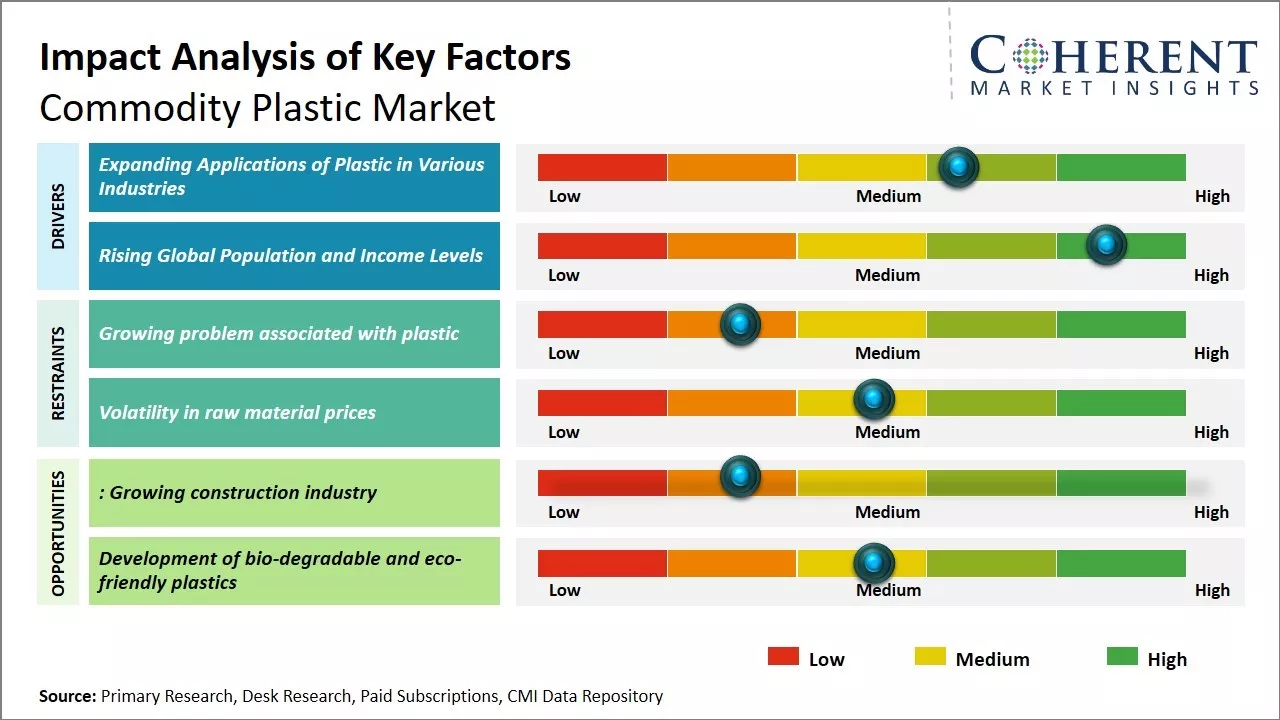
Discover market dynamics shaping the industry: Download Free Sample
The market is expected to witness positive growth over the forecast period due to increasing applications of plastics in industries. The demand for plastics is driven by its versatile properties and lower production costs. Various products across industries such as packaging, automotive, electronics, healthcare and others use plastics extensively. The rising population and urbanization in developing countries are further fueling the demand for plastics. Additionally, innovations in polymer formulations to reduce plastic waste and the development of bio-based plastics are expected to offer opportunities for market growth during the forecast period. However, stringent regulations around plastic usage and awareness regarding environmental pollution caused by plastics may hamper the market growth to some extent.
Expanding Applications of Plastic in Various Industries
The use of plastics has been increasing exponentially in various industrial applications over the past few decades. While plastics were initially mainly utilized for packaging and consumer goods, engineers and manufacturers have increasingly found innovative ways to leverage the unique properties of plastics including their light weight, durability, and versatility. Plastics are now increasingly replacing traditional materials like metals, wood, and glass in many applications. In the automotive industry, plastic usage has risen dramatically as auto manufacturers look to reduce vehicle weight and improve fuel efficiency. Modern vehicles now contain numerous plastic components such as parts for the interior, exterior body panels, fuel systems, electrical components and more. Even complex structural parts that were traditionally made of heavier metals are now being produced using advanced lightweight plastics. The aerospace industry has also embraced plastics to produce light yet durable components for aircraft interiors and exteriors. This trend is driven by the need to reduce aircraft weight and boost fuel efficiency.
Market Concentration and Competitive Landscape
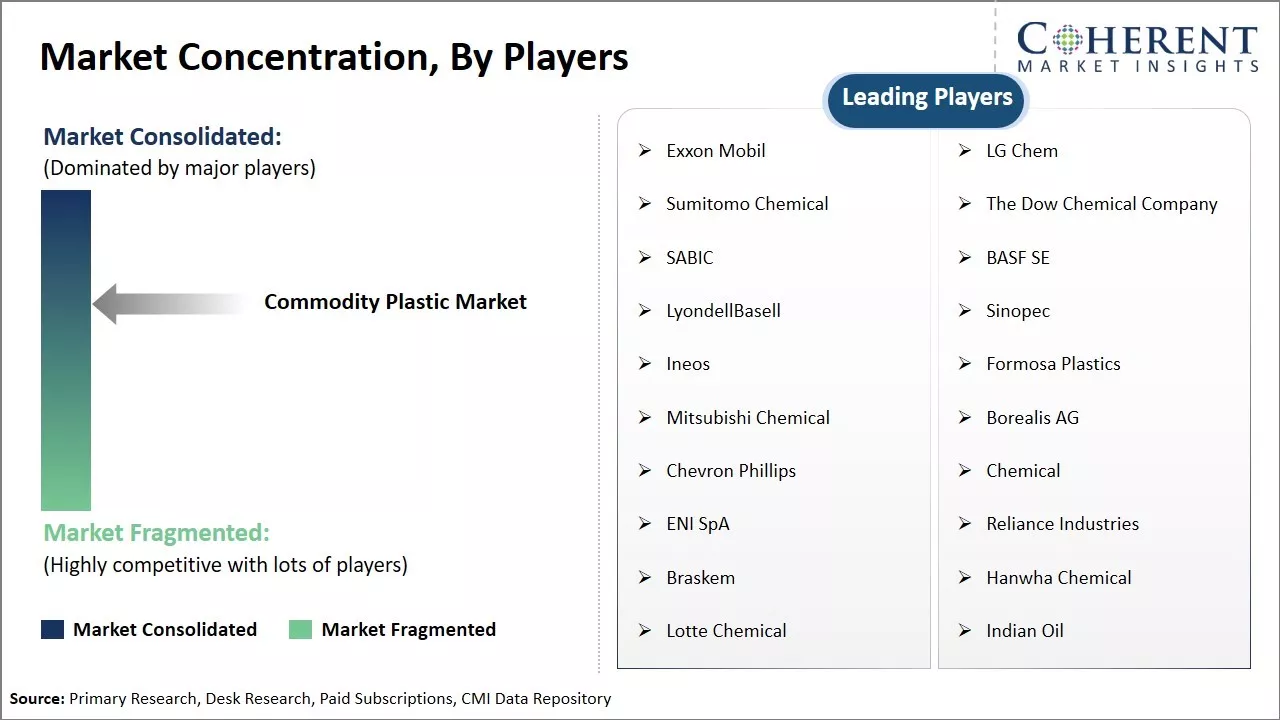
Get actionable strategies to beat competition: Download Free Sample
Rising Global Population and Income LevelsAs the world population climbs towards the 9 billion mark over the next couple of decades, there will be significant rise in the demand for basic consumer goods and services that require plastics in their production and packaging. Plastics are commonly used in industries like consumer durables, food and beverages, personal and healthcare due to their low cost and versatility. As populations grow, consumption of such goods is projected to see exponential uptick. This burgeoning demand is further bolstered by improving economic conditions. Regions like Asia Pacific, Africa, and Latin America that constituted the bulk of global population increase in recent years have also witnessed strong GDP growth rates. As household incomes grow in developing nations, spending capacity on basic necessities as well as discretionary items increases substantially. This promotes the use of affordable yet functional plastic alternatives over traditional materials. For instance, rising affluence has hugely boosted packaged foods and bottled beverages consumption in countries like India, Indonesia, and Nigeria which rely heavily on plastics for packaging. According to the United Nations Department of Economic and Social Affairs data, though population grew across all regions between 2015 and 2020, Africa saw the highest annual rate of change of around 2.5%. This translates too many new consumers being added each year who will contribute to higher penetration of goods packaged in plastics. Similarly, the World Bank figures show average incomes increasing in lower-middle income economies like Vietnam, Philippines, and Kenya during the 2020-22 time period amid post pandemic recovery, signifying greater demand potential.
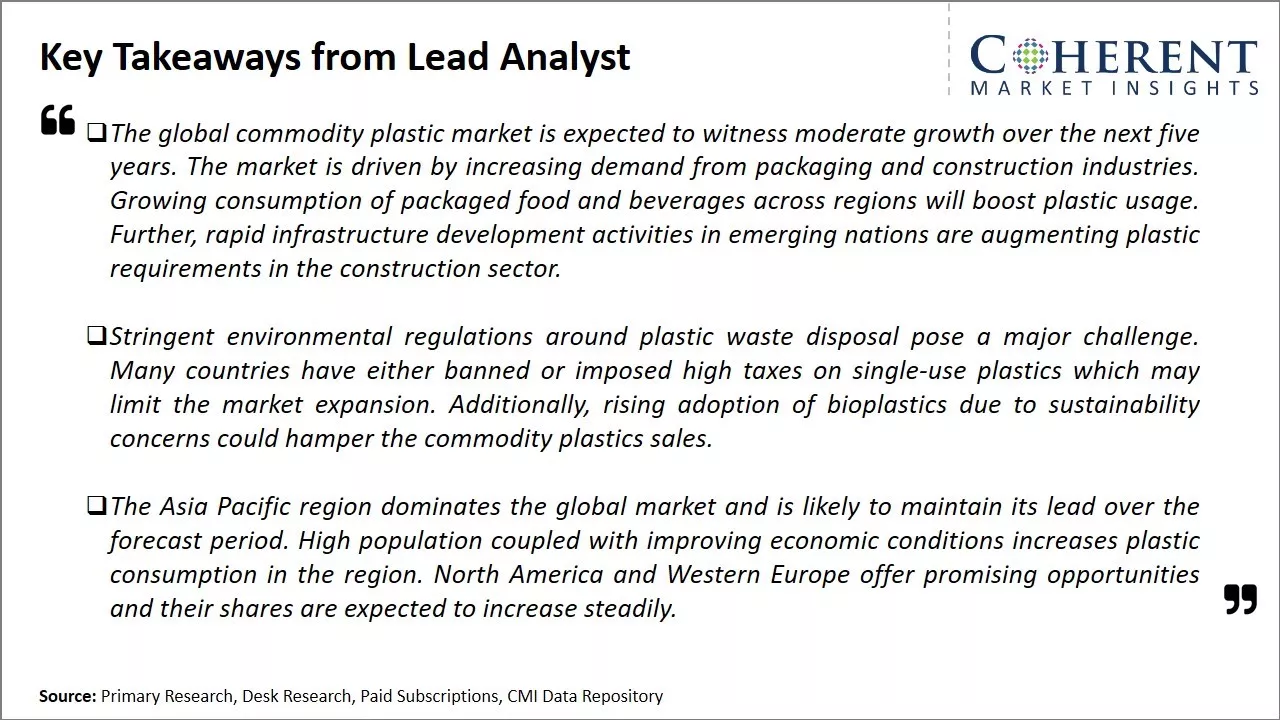
To learn more about this report, Download Free Sample
Market ChallengesGrowing problems associated with plasticThe commodity plastic market faces several challenges. Plastic waste is a growing problem as most plastics are not biodegradable and incinerating plastic waste releases harmful emissions. Many countries have implemented policies to reduce plastic usage which impacts demand. Volatility in oil prices also poses a challenge as plastics are produced from oil and gas. High oil prices increase production costs for plastic manufacturers. Substitute materials like paper and bioplastics are growing in popularity as more brands commit to eliminating single-use plastics.
Market Opportunities: Growing construction industry
The construction industry's demand for plastics continues to rise with growing infrastructure projects around the world. Medical applications of plastics also provide opportunities as more medical devices use plastics. Light-weighting of vehicles involve increasing plastic content which can boost demand. Advancements in recycling technologies may help address the plastic waste problem and create a sustainable supply of recycled plastic content.
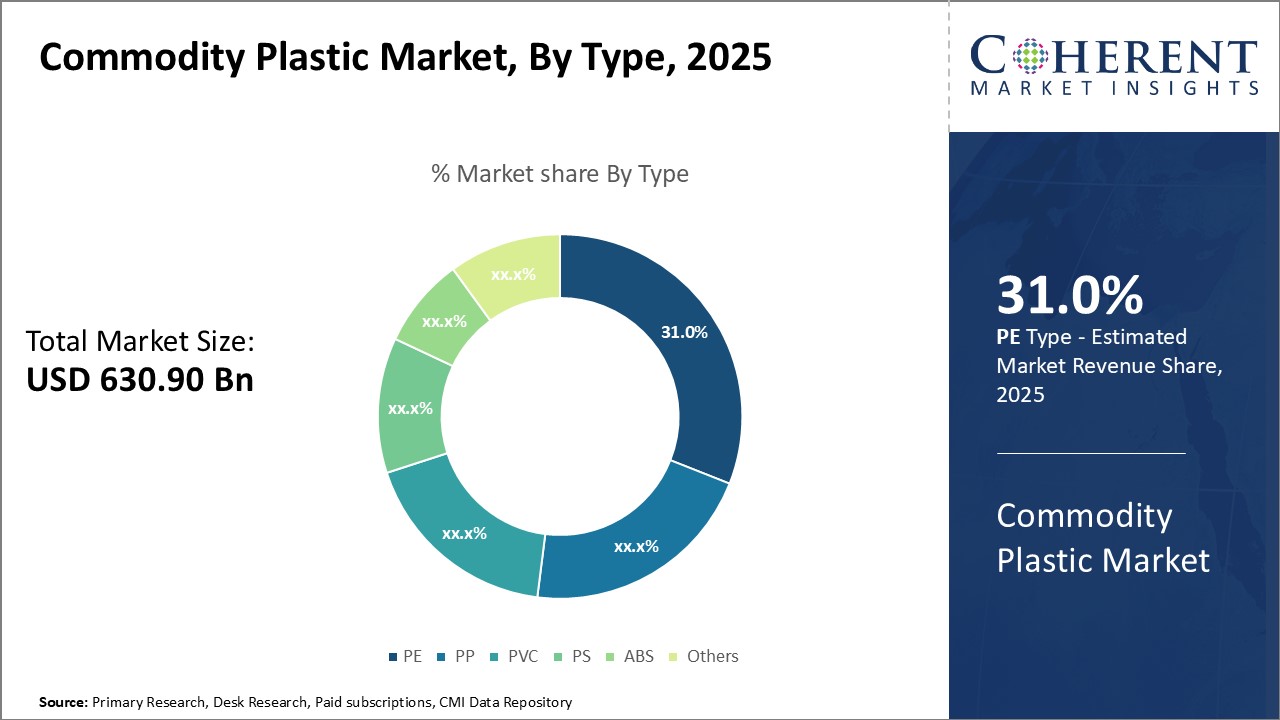
Discover high revenue pocket segments and roadmap to it: Download Free Sample
Insights, By Type: PE Dominates the Plastic Market Due to Wide ApplicationsPolyethylene (PE) contributes 31.0% share of the global commodity plastic market owing to its widespread applications across multiple industries. PE is widely used in packaging materials due to its chemical resistance, moisture barrier properties, and stress cracking resistance. Films made from PE are ideal for food packaging as they prevent contamination and allow visibility of products. PE is also used extensively in plastic bags and sacks due to properties like high strength, flexibility, and durability. In construction, PE finds applications in pipes for drainage, water supply, and sewage systems. Its corrosion resistance and flexibility make it suitable for underground piping applications. PE sheets are also used for covering, insulation, and waterproofing in construction. Its lightweight, high strength, and weather resistance enable the usage of PE in tarpaulins, garden furniture, and containers. Consumer product manufacturers favor PE for its moldability and stability. Household items like bottles, containers, toys and household appliances utilize PE in their components and packaging. The automotive industry incorporates PE in fuel lines, air intake manifolds, bumpers, dashboards and mud guards owing to its impact and wear resistance.
Insights, by Packaging: Packaging Drives Significant Demand in the Plastic Market
The packaging segment contributes 41.6% share in the commodity plastic market owing to increased plastic usage in the packaging industry. Plastic packaging offers advantages of lightweight and durability, ease of printing and decoration, protective barrier, and sealability. These properties allow plastic to replace traditional materials and provide innovative packaging solutions. Food packaging is a major driver of plastic demand with rising food consumption and changing lifestyles increasing the need for convenient and long shelf-life packaged food and beverages. Plastic bottles and containers have become ubiquitous in packaging of beverages, edible oils, sauces, and other food items. Non-food packaging has also increased usage of plastic sachets, bags, films, and thermoformed containers for packaging of consumer and industrial products.
The e-commerce boom has proliferated plastic usage, utilizing plastic mailers, bags, bubble wraps, and boxes for product and shipping packaging. The healthcare industry also incorporates high amounts of plastic in packaging of medical devices, pharmaceuticals, and other supplies owing to its moisture and gas barrier properties essential for sterile packaging. With the trend of nuanced on-the-go consumption, demand has increased for small and multipack packaging, introducing more plastic usage. Plastic packaging versatility, barrier properties, and light weight have enabled it to replace traditional packaging, driving significant consumption within the packaging segment.
Regional Insights
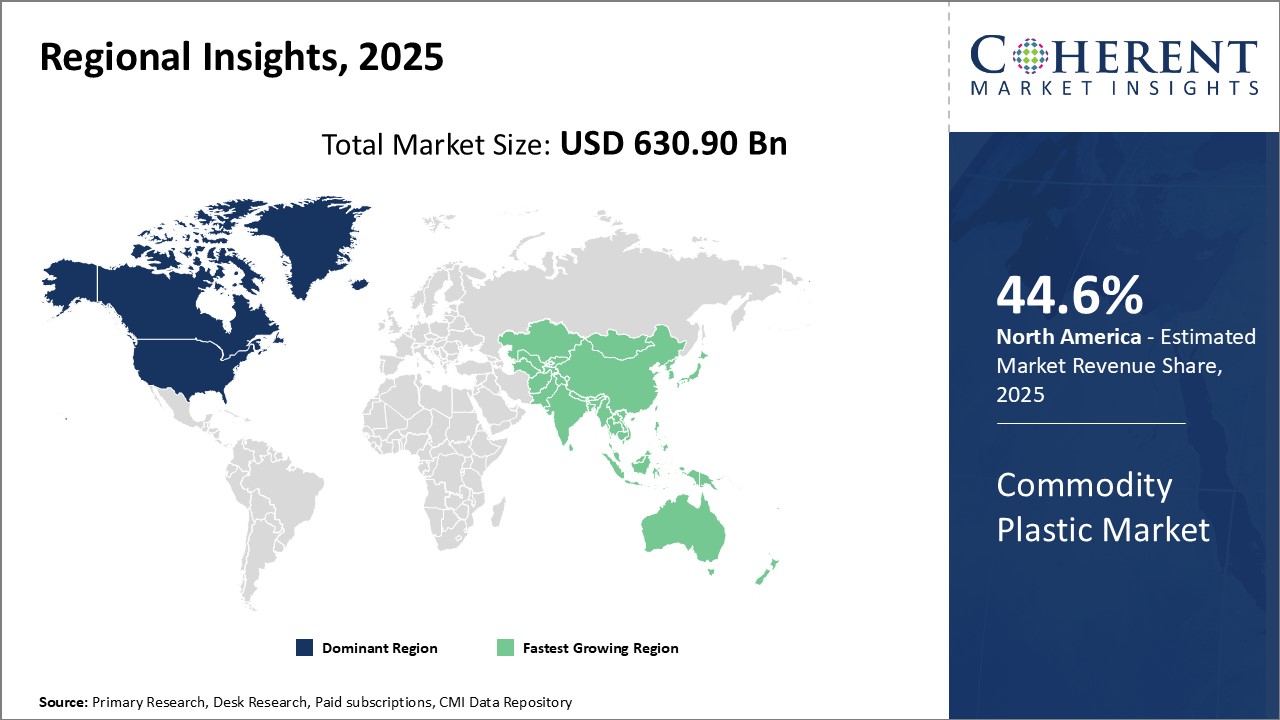
Need a Different Region or Segment? Download Free Sample
North America has established itself as the dominant region in the global commodity plastic market with 44.6% of the market share. The U.S., in particular, accounts for the largest share due to a strong demand from end-use industries such as packaging, construction, automotive, and consumer goods. Several factors have contributed to North America's leading position. The extensive petrochemical industry infrastructure allows for the reliable supply of key plastic resins such as polyethylene, polypropylene, and PVC. Major plastic resin producers have built massive integrated production facilities across the US Gulf Coast and Midwest regions to capitalize on availability of raw materials. In addition, government policies promote domestic manufacturing and have helped the plastics industry become a major employment generator.
Asia Pacific has emerged as the fastest growing regional market for commodity plastics. Rapid industrialization and rising incomes across developing nations like China, India, Indonesia, and Vietnam are driving exponentially higher demand for plastics in everything from consumer goods to infrastructure and construction. This region is also undergoing huge investments to build new petrochemical complexes that can supply virgin plastic resins to cater to ballooning domestic needs. Asian countries have also liberalized trade policies in recent years to encourage the global petrochemical companies to set up integrated production hubs and partner with local players. Meanwhile, cost competitiveness makes Asia pacific an attractive sourcing destination for finished plastic goods, giving a boost to plastic resin imports. As Asia's middle class population multiplies over the coming decades, the region's commanding position at the center of global plastics demand and supply chains is poised to strengthen further.
Market Report Scope
Commodity Plastic Market Report Coverage
| Report Coverage | Details | ||
|---|---|---|---|
| Base Year: | 2024 | Market Size in 2025: | USD 630.90 Bn |
| Historical Data for: | 2020 To 2024 | Forecast Period: | 2025 To 2032 |
| Forecast Period 2025 to 2032 CAGR: | 6.3% | 2032 Value Projection: | USD 968.23 Bn |
| Geographies covered: |
|
||
| Segments covered: |
|
||
| Companies covered: |
Exxon Mobil, LG Chem, Sumitomo Chemical, The Dow Chemical Company, SABIC, BASF SE, LyondellBasell, Sinopec, Ineos, Formosa Plastics, Mitsubishi Chemical, Borealis AG, Chevron Phillips, Chemical, ENI SpA, Reliance Industries, Braskem, Hanwha Chemical, Lotte Chemical, and Indian Oil |
||
| Growth Drivers: |
|
||
| Restraints & Challenges: |
|
||
Uncover macros and micros vetted on 75+ parameters: Get instant access to report
Commodity Plastic Industry News
- In 2023, S&P Global Commodity Insights launched India’s first price assessment for R-PET
- In May 2020, Sumitomo, a Japan-based multinational corporation, announced an investment in NanoScent, an Israel-based startup company. The purpose of this investment was to support the development of a rapid diagnostic sensor for COVID-19. By partnering with NanoScent, Sumitomo aimed to contribute to the global fight against the pandemic by providing a fast and reliable testing solution.
- In May 2020, LyondellBasell, a leading chemical company, revealed that Advanced Global Investment Company in Saudi Arabia had chosen its polypropylene technology for a new facility. This selection highlighted the confidence in LyondellBasell's advanced polypropylene technology and its suitability for the development of cutting-edge manufacturing facilities.
- In December 2020, Blue Sky Energy in the U.S. chose LyondellBasell's Polypropylene Technology for the construction of a new facility in Wenzhou, Zhejiang Province, China. This selection signifies the recognition of LyondellBasell's advanced polypropylene technology by Blue Sky Energy for their expansion into the Chinese market. The collaboration between the two companies reflects a strategic partnership aimed at leveraging cutting-edge technology to meet the growing demand for polypropylene in the region.
*Definition: The commodity plastic market consists of basic plastic resins that are highly interchangeable, commodity products manufactured on a massive scale primarily for packaging applications. The major resins traded in this market include polyethylene, polypropylene, polystyrene, and polyvinyl chloride. These resins are undifferentiated, bulk products for use across a wide range of industries and lack distinctive brand identities or customized specifications compared to specialty plastics.
Share
Share
About Author
Yash Doshi is a Senior Management Consultant. He has 12+ years of experience in conducting research and handling consulting projects across verticals in APAC, EMEA, and the Americas.
He brings strong acumen in helping chemical companies navigate complex challenges and identify growth opportunities. He has deep expertise across the chemicals value chain, including commodity, specialty and fine chemicals, plastics and polymers, and petrochemicals. Yash is a sought-after speaker at industry conferences and contributes to various publications on topics related commodity, specialty and fine chemicals, plastics and polymers, and petrochemicals.
Missing comfort of reading report in your local language? Find your preferred language :
Transform your Strategy with Exclusive Trending Reports :
Frequently Asked Questions
EXISTING CLIENTELE
Joining thousands of companies around the world committed to making the Excellent Business Solutions.
View All Our Clients
